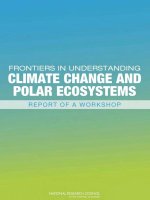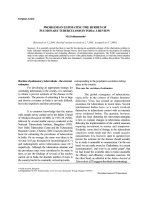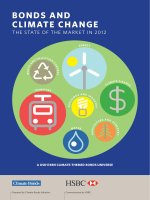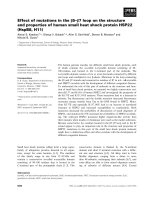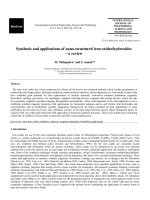Climate change and epidemiology of human parasitosis in Egypt: A review
Bạn đang xem bản rút gọn của tài liệu. Xem và tải ngay bản đầy đủ của tài liệu tại đây (480.53 KB, 7 trang )
Journal of Advanced Research (2014) 5, 607–613
Cairo University
Journal of Advanced Research
REVIEW
Climate change and epidemiology of
human parasitosis in Egypt: A review
Wael M. Lotfy
Parasitology Department, Medical Research Institute, Alexandria University, Egypt
A R T I C L E
I N F O
Article history:
Received 18 March 2013
Received in revised form 20 June 2013
Accepted 21 June 2013
Available online 28 June 2013
Keywords:
Climate change
Egypt
Parasite
Infection
Epidemiology
A B S T R A C T
Climate change is an emerging global issue. It is expected to have significant impacts both in
Egypt and around the world. Thus, the country is in need for taking action to prepare for
the unavoidable effects of climate change, including the increase in water stress, the rise in
sea level, and the rapidly increasing gap between the limited water availability and the escalating
demand for water in the country. Also, weather and climate play a significant role in people’s
health. Direct impacts of climate change on the Egyptians public health may include also
increased prevalence of human parasitic diseases. Climate could strongly influence parasitic diseases transmitted through intermediate hosts. The present work reviews the future of such parasitic diseases in the view of the current available evidence and scenarios for climate change in
the Egypt.
ª 2013 Production and hosting by Elsevier B.V. on behalf of Cairo University.
Wael M. Lotfy received his PhD from the
Alexandria University, Egypt in 2001. He was
promoted as Professor, University of Alexandria, Egypt in 2011. He is a recipient of
Alexandria University Award for Encouraging of Scientific Research (2006), Alexandria
University Award for Encouraging of Scientific Publications (four times) and has been
listed in ‘Marquis Who’s Who in the World’
since 2009, ISBN: 9780837911410. He underwent nine months of training in Rome on
Molecular and Classical Parasitology and has travelled five times in
scientific missions as a visiting scholar in Biology Department,
E-mail address:
Peer review under responsibility of Cairo University.
Production and hosting by Elsevier
University of New Mexico, USA during the period 2004–2010. He has
published 23 papers in reputed journals and three books. His name has
been recorded in the international reviewer panels of many journals.
He has organised several workshops and has been involved in various
projects. He is a member of the Egyptian Parasitologists United
(EPU), the Egyptian Society of Parasitology, the Egyptian Association
of advancement of Medical Basic Sciences (EAMBS), the Eastern
Mediterranean Health Genomics and Biotechnology Network
(EMHGBN) and Member of the German Egyptian network of young
scientists (GENYS).
Introduction
Climate change is now widely accepted as a fact. Evidence of
such change includes the instrumental temperature record, rising sea levels, and decreased snow cover in the Northern
Hemisphere. Scientists projected future changes in air and
2090-1232 ª 2013 Production and hosting by Elsevier B.V. on behalf of Cairo University.
/>
608
W.M. Lotfy
sea surface temperatures, as well as changes in precipitation,
sea level, and ocean salinity and circulation patterns. These
environmental changes are likely to have an impact on all
the natural ecosystems and socioeconomic systems [1,2].
In 2000, the Intergovernmental Panel on Climate Change
(IPCC) issued a Special Report on Emission Scenarios (SRES)
that presented more than 40 scenarios based on different visions
of how the world may develop in the 21st century, the sources of
energy it will use, and how the communities will solve their problems. Based on the SRES, an array of serious threats is apparent
to develop in Egypt with the climate change [3].
Egypt is generally an arid country that depends on the Nile
River as its main and almost exclusive source of fresh water.
At present, it is the largest consumer of the Nile water. It is
one of the African countries that could be vulnerable to water
stress under climate change [3]. The river is very sensitive to temperature and precipitation changes mainly because of its low
runoff/rainfall ratio which is 4% [4]. Because of being at the bottom end of the river, Egypt is affected by the climate change impacts, not only within its borders, but also within the whole
basin, which it shares with ten other countries. Egypt will be
likely to experience an increase in water stress with a projected
decline in precipitation [5]. At present, there is a rapidly increasing gap between the limited water availability and the escalating
demand for water in the country. The rate of water utilization
has already reached its maximum for Egypt, and climate change
will exacerbate this vulnerability. The quantity of water used in
2000 was estimated at about 70 km3 which is already far in excess of the available resources [6]. Temperature rise is expected
to reduce the productivity of major crops and increase their
water requirements, thereby directly decreasing crop water-use
efficiency [7,8]. This situation may be complicated by a general
increase in irrigation demand [9]. The ongoing expansion of irrigated areas will reduce the capacity of Egypt to cope with future
fluctuation in flow [10].
In addition, climate change is likely to cause rise in sea level
as a consequence of global warming. This could affect the Nile
Delta and other coastal areas [11]. Coastal cities such as Alexandria (Egypt’s second city) will probably be impacted and
could be completely lost [12].
Direct impacts of climate change on Egypt may include also
increased prevalence of many parasitic diseases, physiological
disorders, skin cancer, eye cataracts, respiratory ailments, heat
strokes, and heat related illnesses. The indirect impacts involve
factors such as demographic dislocations and socioeconomic
disruptions. However, comprehensive studies that contain detailed estimations and correlations between climate change
and human health are still lacking for Egypt [13]. For the interest of the public health in the country, it becomes crucial to review how human parasites may respond to the climatic change
expected in next decades, according to results obtained with
forecasting climatic models.
Impacts of climate change on human parasitosis in Egypt
Climate change could strongly affect diseases transmitted
through insects, snails, and other cold blooded animals
Table 1 Potential range of effects of climate on disease transmitted to man through other hosts. Adapted from McMichael and his
coauthors in 2001 [19].
Climate Factor
Intermediate host
Pathogen
Vertebrate host and rodents
Increases in
temperature
– Decreased survival (e.g., Culex tarsalis)
– Change in susceptibility to some pathogens;
seasonal effects
– Increased population growth
– Increased feeding rate to combat dehydration,
therefore increased vector-human contact
– Expanded distribution seasonally and spatially
– Increased rates of extrinsic
incubation in vector
– Extended transmission season
– Expanded distribution
– Warmer winters favor rodent
survival
Decreases in
precipitation
– Increase in container-breeding mosquitoes
because of increased water storage
– Increased abundance for vectors that breed in
dried-up river beds
– Prolonged droughts could reduce or eliminate
snail populations
– No effect
– Decreased food availability
can reduce populations
– Rodents may be more likely
to move into housing areas,
increasing human contact
Increases in
precipitation
– Increased rain increases quality and quantity
of larval habitat and vector population size
– Excess rain can eliminate habitat by flooding
– Increased humidity increases vector survival
– Persistent flooding may increase potential snail
habitats downstream
– Heavy rainfall events can synchronize vector
host-seeking and virus transmission
– Little evidence of direct
effects
– Some data on humidity effect
on malarial
parasite
development
in
anopheline mosquito host
– No effect
– Increased food availability
and population size
– Coastal flooding affects vector abundance for
mosquitoes that breed in brackish
water (e.g., Anopheles subpictus and Anopheles
sundaicus malaria vectors in Asia)
– No effect
– No effect
Increase in
precipitation
extremes
Sea-level rise
– Risk of contamination of
flood waters/runoff with
pathogens from rodents or
their excrement (e.g., Leptospira from rat urine)
Climate change and human parasitosis in Egypt
(Table 1). Intermediate hosts of human infections are sensitive
to subtle temperature, precipitation, and humidity changes.
However, diseases that require intermediate hosts are also
dependent on many other interacting factors. Although there
has been a resurgence of infectious diseases in recent years, it
is unclear that climate change has played a significant role.
Other factors such as the movement of human and animal
populations, the breakdown of public health infrastructure,
changes in land use, and the emergence of drug resistance have
been contributory [14].
The capacity of climatic conditions to modulate the distribution and intensity of human parasitosis is well documented
[15]. Climatic conditions especially global warming strongly affect the survival and distribution of the intermediate hosts (insects, snails, and other cold blooded animals) and also directly
influence the development and reproduction of parasites carried by them [16]. In addition, climate change may also expand
the current limits of agricultural activities, increasing the
chance of contact between species that have not normally
interacted in that area. Animal livestock may be infected with
microorganisms which have zoonotic potential and can be
transmitted to humans [17]. Also, global warming is expected
to enhance the northern spread of diseases. As northern countries warm, disease-carrying intermediate hosts will migrate
north, carrying pathogens with them. Concerning the southern
borders of Egypt, many arthropod-borne parasitic diseases
were reported in sub-Saharan Africa and Sudan. These are
malignant malaria, African trypanosomiasis, (Trypanosoma
b. gambiense and possibly T. b. rhodesiense), loiasis (infection
with the nematode species Loa loa), and onchocerciasis (infection with Onchocerca volvulus) [18].
Mosquito-borne diseases
Malaria
Malaria is the world’s most important vector-borne disease. Of
all infectious diseases, malaria continues to be one of the biggest contributors to the global disease burden in terms of death
and suffering. It is caused by parasites of the genus Plasmodium. The infection is transmitted to humans through the bites
of female mosquitoes of the genus Anopheles. Four species of
Plasmodium are pathogenic to humans: P. falciparum, P. malariae, P. vivax, and P. ovale. Plasmodium falciparum is the
most common species in tropical areas and the most dangerous
clinically. Plasmodium malariae is much less apparent, with
low parasitemia, and found mainly in tropical Africa. Plasmodium vivax has the most extensive geographic range and is
present in many temperate zones as well as the tropics and subtropics. Plasmodium ovale resembles P. vivax and replaces it in
West Africa [20,21].
In Africa, distribution of the disease is greatly limited by
climate, except at the southern limit [20]. Using the climate
change scenarios, modeling experiments suggest a 5–7% potential increase in malaria distribution in Africa by 2100, primarily expanding malaria’s altitudinal reach rather than
latitudinal. An overall increase in person-months of exposure
risk to malaria will be 16–28%, largely because of a prolonged
transmission season [22]. Generally speaking, this topic is of
intense controversy, and our understanding will continue to
evolve as new research data are generated.
609
Evidence for human malaria infection in Egypt dates
back to the Pharaonic times [23]. Since the 15th century,
documented cases of malaria have been periodically reported in different parts of Egypt. In 1900, one third of
the population of the Suez Canal area was reported to
be infected with malaria. In 1942, an outbreak of malaria
occurred in Nubia as a result of an invasion of the efficient
vector, Anopheles gambiae, from Sudan. This epidemic
lasted for almost four years where several hundreds of
cases and deaths were recorded. Periodically, every few
years, semi-epidemics occur in different parts of the country. This is probably related to special climatological and
hydrological changes that cause the flourishing of a high
density of the vector species. Historically, the three species
of malaria were reported from Egypt: P. vivax, P. falciparum, and P. malariae [24]. Among all the anophelines present in Egypt, only four species are known to be efficient
vectors of malaria; A. pharoensis, A. sergentii, A. stephensi,
and A. superpictus. Anopheles pharoensis was found to be
distributed all over Egypt, especially in the Delta. Anopheles
sergentii proved to be the number one vector in the Oases
of the Western Desert and Fayoum. Anopheles stephensi (in
the Red Sea Coast) and A. superpictus (in Sinai) are known
to be malaria vectors in other countries; however, they
were not caught infected in Egypt [24].
Anopheles sergentii may be of a particular interest in projection of the future trends of the disease in Egypt. This species is known as the ‘‘oasis vector’’ or the ‘‘desert malaria
vector’’ due to its distribution within oases across the Saharan belt in northern Africa and its ability to cope with the
extreme climate across this region [25]. As mentioned above,
in Egypt, it was found in the Oases of the Western Desert,
Fayoum, and as south as Aswan and Toshka which represent the southernmost distribution in northern Africa
[18,25,26]. Anopheles sergentii is highly zoophilic, and it is
an indiscriminate biter of both humans and animals, both
indoors and outdoors [27]. The key factor that limits oasis
malaria transmission in Egypt is the zoophilic feeding behavior of A. sergentii [28]. As mentioned above, Egypt could be
vulnerable to water stress and reduction crop productivity
due to the climate change. To overcome this problem, the
Egyptian government started to use the huge underground
water reserves in the Western Desert in irrigation/agricultural projects. The new settlements may help in emergence
of malaria due to the presence of the zoophilic A. sergentii
the vector of the disease there.
The main vector species of malaria in Africa are the A.
gambiae complex. They are the most efficient vectors in the
world and are a major factor in the high burden of disease
in the continent. In 1943, a major malaria epidemic occurred
in Egypt associated with the spread of A. arabiensis (a member
of the A. gambiae species complex) from Sudan along the Nile
Valley [29,30]. This anopheline invasion was associated with
greatly increased traffic into Egypt from Sudan, due to wartime difficulties of shipping in the Mediterranean. The gambiae-transmitted malaria struck as far north as Assiut, some
320 km from Cairo. It produced some 130,000 deaths within
a two-year period until successful control measures were
implemented in late 1944 [29]. In 2010, Menegon and his colleagues reported that malignant malaria is common in Sudan
with antimalarial drug resistance mainly in P. falciparum [31].
With global warming and the continuous increase in tempera-
610
ture, it is possible that A. gambiae expands its range of distribution to Egypt. This situation may be further complicated by
the presence of A. sergentii in Aswan and Toshka [18,26].
Also, Toshka and other irrigation/agricultural projects in the
south of Egypt and north of Sudan may further facilitate
the anopheline expansion
north.
Climate change may contribute to the resurgence of malaria in areas where the public health infrastructure is insufficient (e.g., in rural areas). Human infections with P.
falciparum were reported in Egyptian patients who were recruited from Peacekeeping Mission Forces in Sudan [32].
Such imported cases may initiate spread of the disease to
new rural foci. In regions where malaria has been locally
eliminated but the vectors persist, there is a theoretical but
small risk of localized outbreaks that could increase under
climate change. Although malaria has been successfully
eradicated from most foci in Egypt, the vectors are still present, and there is probability of emergence/re-emergence of
the disease. Very few sporadic cases of malaria are still diagnosed in Egypt [32]. The most obvious example is Fayoum
which was categorized as a high risk area for malignant malaria during the last two decades [33,34].
Lymphatic filariasis
Lymphatic filariasis (elephantiasis) affects an estimated 120
million people in tropical areas of the world. Endemic foci
are found in sub-Saharan Africa, Egypt, southern Asia, the
western Pacific Islands, the north-eastern coast of Brazil,
Guyana, Haiti, and the Dominican Republic. Since most
infections are asymptomatic, many go unrecognized. The
disease is known to be endemic in rural areas of Egypt.
It is an infection with the nematode Wuchereria bancrofti
and transmitted by Culex pipiens mosquitoes. The disease
has a focal distribution, and it is estimated that currently
over 2.5 million people are at risk of acquiring filariasis.
It is considered one of the most important vector-borne
diseases in Egypt, posing a major public health problem
in six governorates in the Nile Delta (Qalyoubia, Menoufia,
Sharkia, Kafr El-Sheikh, Dakahlia, and Gharbia) and the
governorates of Giza and Assiut in Upper Egypt [35].
In 1997, the World Health Assembly passed a resolution
calling for ‘‘the elimination of lymphatic filariasis as a public
health problem’’. Accordingly, the World Health Organization
(WHO) developed a new strategy and initiated a global program for the elimination of lymphatic filariasis as a public
health problem by the year 2020 [36]. Egypt was among the
first countries to join the WHO global program. In 2000, a national program for elimination of lymphatic filariasis was initiated. In the years of the focalized control campaign, Egypt
had made substantial progress in decreasing microfilaria prevalence [35].
In 2012, Slater and Michael used ecological niche modeling
to map the current potential distribution of lymphatic filariasis
in Africa and to estimate how future changes in climate and
population could affect its spread and burden across the continent. They estimated that populations at risk to lymphatic filariasis may range from 543 to 804 million and that this could
rise to between 1.65 and 1.86 billion in 2050 depending on the
climate scenario [37].
W.M. Lotfy
Fly-borne diseases
Leishmaniasis
Sandflies are important vectors of leishmaniasis, a vectorborne zoonotic disease which is endemic in 88 countries
throughout Africa, Asia, Europe, and North and South America. The insect vectors are over 50 species of the genus Phlebotomus in the Old World and genus Lutzomyia in the New
World. Rodents, dogs, wild cats, jackals, foxes, sloths, hyraxes, and other carnivores are the main animal reservoirs in
nature. The disease manifests mainly in three forms: visceral,
cutaneous, and mucocutaneous [38,39]. Sandflies of the genus
Phlebotomus (Family: Psychodidae) are widely distributed
across the Middle East, from Morocco to Egypt, and the Arabian Peninsula to Jordan, Turkey, and Iran [40]. Nine species
of Phlebotomus were reported in Egypt [41]. Two forms of
leishmaniasis have been reported in Egypt, cutaneous leishmaniasis in Sinai [42] and visceral leishmaniasis in the northern
costal margins [43]. Three species of Leishmania are known to
be endemic in Egypt: L. infantum which causes zoonotic visceral leishmaniasis, L. major which causes zoonotic cutaneous
leishmaniasis, and L. tropica which causes cutaneous leishmaniasis [40,42,43]. Leishmania donovani DNA was detected in
samples taken from ancient Egyptian and Nubian mummies
that originate from around 4000 B.C. [44]. Since 1904, rare
cases of visceral leishmaniasis have been reported in Egypt;
some were imported, others were probably autochthonous. A
focus of visceral leishmaniasis was discovered in El-Agamy
area, 25 km west of Alexandria in 1982 [45]. The last case in
El-Agamy area was reported in 2005, and only one more case
of visceral leishmaniasis was reported in the Suez region in
2008. It should be noted here that due to a lack of awareness
among medical practitioners, visceral leishmaniasis is suspected to be underreported [46]. Cutaneous leishmaniasis has
been an increasing problem in Egypt [47]. Known foci are
among nomads in North Sinai with 471 reported cases in
2008 [48].
Sudan is one of the highly endemic countries for visceral
leishmaniasis or kala-azar, which is thought to have originated
in country and later spread to the Indian subcontinent and the
New World [49]. Since the early 1900s, visceral leishmaniasis
has been among the most important health problems in Sudan,
especially in the eastern and central regions. Several major epidemics have been reported; the most recent was in 1988 and
occurred in Western Upper Nile province in southern Sudan.
The disease spread to other areas that were previously not
known to be endemic. Epidemiological and entomological
studies confirmed Phlebotomus orientalis as the vector in several parts of the country. Infection rates with Leishmania were
high, but subject to seasonal variation, as were the numbers of
sand flies. Parasites isolated from humans and sand flies were
identified as L. donovani [50].
Global warming is increasingly being implicated in species’
range shifts throughout the world, including those of important vector and reservoir species for infectious diseases [51].
In North America, leishmaniasis is autochthonous in Mexico
and Texas and has begun to expand its range northward. Ecological niche models of vector and reservoir species predict that
climate change will exacerbate the ecological risk of human
exposure to leishmaniasis in areas outside its present range
Climate change and human parasitosis in Egypt
in the United States and, possibly, in parts of southern Canada
[52]. A similar scenario for expansion of visceral leishmaniasis
from its range in Sudan to southern areas in Egypt is expected.
The effect of climate change on the present foci of the disease
in Northern areas of the country requires further studies. To
the best of our knowledge, cutaneous leishmaniasis has been
an increasing problem in Egypt [47]. Thorough epidemiological studies are required to pinpoint the factors responsible
for such increase.
Mechanically transmitted parasites
The housefly (Musca domestica) can serve as mechanical carrier
of pathogens including many parasites. Protozoal cysts and helminth eggs can be carried on wings, legs, and body hairs of the fly
and transmitted to human food and drinks. Climate change is
also predicted to have major effects on flies of public health significance in domestic premises; thus, climate change models have
predicted that housefly population could increase substantially,
with increases of up to 244% by 2080. In light of this predicted
increase in numbers, the role of houseflies as vectors of parasites
and other pathogenic organisms is likely to take on greater
importance [53].
Snail-borne parasitic infections
Freshwater snails that transmit parasitic digeneans generally
prefer stagnant or slow moving water [54]. The increase in water
stress expected to accompany climate change in Egypt may result in reduction in water currents in irrigation and drainage canals. In addition, construction of dams and irrigation projects
reduce the speed of freshwater currents. These two factors may
help the freshwater population to flare up in the future.
Schistosomiasis (Bilharzia)
In Egypt, schistosomiasis is caused by the two species Schistosoma mansoni and S. haematobium. The snail intermediate host
of S. mansoni is Biomphalaria alexandrina, while the snail host
of S. haematobium is Bulinus truncatus [55]. The schistosome
larvae must infect the snail before escaping into water, seeking
a human host. The abundance of the parasite is in direct proportion to that of the snail population. Abundance of snails is
dependent on the type of vegetation in the habitat, seasonal
rain variation, and changes in water temperature and flow
[14]. In the Nile Delta and Valley in Egypt, the prevalence of
schistosomiasis parallels the construction of new irrigation
projects. With the construction of Aswan Dams in Egypt,
year-round irrigation became possible, and the snail populations dramatically increased [55]. As mentioned above, Egypt
could be vulnerable to water stress and reduction in crop productivity due to the climate change. To overcome this problem,
the Egyptian government may construct new irrigation/agricultural projects which will increase schistosomiasis prevalence
and disease spread to new foci.
Fascioliasis
Fasciola hepatica and F. gigantica are the causing agents of
fascioliasis in humans and animals. Both species are endemic
611
in Egypt [56]. At present, fascioliasis is emerging/re-emerging
disease in many regions of Latin America, Africa, Europe,
and Asia, both at animal and human levels. Most human
cases are known in Andean countries (Bolivia, Peru, Chile,
Ecuador), the Caribbean area (Cuba), northern Africa
(Egypt), western Europe (Portugal, France and Spain), and
the Caspian area (Iran and neighboring countries) [57].
The incidence of fascioliasis in humans and animals has
been related to air temperature, rainfall and/or potential
evapotranspiration. These factors affect the intermediate
snail host population dynamics and the parasite population
at the level of both the free living larval stages of egg and
metacercaria and the intramolluscan parasitic larval stages
of sporocysts, rediae, and cercariae [58]. The strong dependence of fascioliasis on weather factors indicates that climate
change may have a marked influence on the future evolution
of this disease. The effect of climate changes may dramatically affect the prevalence of the disease in Egypt.
Research gaps on climate change and parasitic diseases in Egypt
Changes in transmission patterns of parasitic diseases are a
likely major consequence of climate change. More information
about the underlying complex causal relationships is needed.
Also, it is crucial to apply such information to the prediction
of future impacts, using more complete, better validated, integrated models. There are three main types of models, used to
forecast future climatic influences on infectious diseases, that
include statistical, process-based mathematical, and landscape-based models. These types of model address somewhat
different questions. Statistical models require the derivation
of an empirical statistical relationship between the current
geographic distribution of the disease and the current location-specific climatic conditions. This describes the climatic
influence on the actual distribution of the disease, given prevailing levels of human intervention (disease control, environmental management, etc.). By then, applying this statistical
equation to future climate scenarios, the actual distribution
of the disease in future is estimated, assuming unchanged levels
of human intervention within any particular climatic zone.
Process-based mathematical models use equations that express
the scientifically documented relationship between climatic
variables and biological parameters, e.g., vector breeding, survival and biting rates, and parasite incubation rates. In their
simplest form, such models express, via a set of equations,
how a given configuration of climate variables would affect
vector and parasite biology and, therefore, disease transmission. Such models address the question: ‘‘If climatic conditions
alone change, how would this change the potential transmission of the disease?’’ Using more complex ‘‘horizontal integration,’’ the conditioning effects of human interventions and
social contexts can also be incorporated. The landscape-based
modeling entails combining the climate-based models described above with the rapidly-developing use of spatial analytical methods, to study the effects of both climatic and
other environmental factors, e.g., different vegetation types often measured, in the model development stage, by groundbased or remote sensors [59,60]. Unfortunately, comprehensive
studies that contain detailed estimations and correlations between climate change and human health are still lacking for
Egypt [13].
612
W.M. Lotfy
Conclusions
Climate change poses an immediate and growing threat to
many countries of the world including Egypt. The country is
in need for taking action to prepare for the unavoidable impacts of climate change, including the increase in water stress,
the rise in sea level, and the rapidly increasing gap between the
limited water availability and the escalating demand for water
in the country. Also, weather and climate play a significant
role in people’s health. Direct impacts of climate change on
Egypt may include also increased prevalence of human parasitic diseases. Climate could strongly influence parasitic diseases transmitted through intermediate hosts. Climatic
conditions especially global warming strongly affect the survival and distribution of the intermediate hosts and also directly influence the development and reproduction of
parasites carried by them. The present work reviews the effect
of the expected climate change in Egypt on the spread and
prevalence of mosquito-borne diseases (malaria and lymphatic
filariasis), fly-borne diseases (leishmaniasis and mechanically
transmitted parasites), and snail-borne parasitic infections
(schistosomiasis and fascioliasis). Comprehensive studies that
contain detailed estimations and correlations between climate
change and human health are still lacking for Egypt. With
the current available evidence and scenarios for climate change
in the Egypt, it would appear that the public health effects of
climate change especially on human parasitic infections is an
emerging issue that needs to be intensively studied.
[5]
[6]
[7]
[8]
[9]
[10]
[11]
[12]
Conflict of interest
The author has declared no conflict of interest.
Compliance with Ethics Requirements
This article does not contain any studies with human or animal
subjects.
[13]
[14]
[15]
Acknowledgement
This research work is part of a research project sponsored by
the IDRC-Canada for establishing Alexandria Research Center for Adaptation to Climate Change (ARCA).
[16]
References
[17]
[1] Poulin R, Mouritsen KN. Climate change, parasitism and the
structure of intertidal ecosystems. J Helminthol 2006;80:183–91.
[2] Rosenzweig C, Casassa G, Karoly DJ, Imeson A, Liu C, Menzel
A, et al. Assessment of observed changes and responses in
natural and managed systems. In: Parry ML, Canziani OF,
Palutikof JP, van der Linden PJ, Hanson CE, editors. Climate
change 2007: impacts, adaptation and vulnerability contribution
of working group II to the fourth assessment report of the
intergovernmental panel on climate change. Cambridge
(UK): Cambridge University Press; 2007. p. 79–131.
[3] IPCC. Special report on emission scenarios. Cambridge (UK):
Cambridge University Press; 2000.
[4] IPCC. The regional impacts of climate change: an assessment of
vulnerability. A special report of the intergovernmental panel on
[18]
[19]
[20]
climate change working group II. Cambridge (UK): Cambridge
University Press; 1998.
Boko M, Niang I, Nyong A, Vogel C, Githeko A, Medany M,
et al. Africa. In: Parry ML, Canziani OF, Palutikof JP, van der
Linden PJ, Hanson CE, editors. Climate change 2007: impacts,
adaptation and vulnerability contribution of working group II
to the fourth assessment report of the intergovernmental panel
on climate change. Cambridge (UK): Cambridge University
Press; 2007. p. 433–67.
Gueye L, Bzioul M, Johnson O. Water and sustainable
development in the countries of Northern Africa: coping with
challenges and scarcity. Africa’s Sustain Develop Bull
2005:24–8.
Abou-Hadid AF. Assessment of impacts, adaptation and
vulnerability to climate change in North Africa: food
production and water resources. AIACC final report (AF 90).
Washington; 2006.
Eid HM, El-Marsafawy SM, Oudai SA. Assessing the impacts of
climate change on agriculture in Egypt: a ricardian approach.
Centre for environmental economics and policy in Africa
(CEEPA) discussion paper no. 16. special series on climate
change and agriculture in Africa. Pretoria: University of
Pretoria; 2006.
Attaher S, Medany MA, Abdel Aziz AA, El-Gindy A.
Irrigation-water demands under current and future climate
conditions in Egypt. Misr J Agr Eng 2006;23:1077–89.
Conway D. From headwater tributaries to international river:
observing and adapting to climate variability and change in the
Nile Basin. Glob Environ Change 2005;15:99–114.
Wahab HM. The impact of geographical information system on
environmental development. Faculty of Agriculture, Al-Azhar
University; 2005.
Elasha BO, Medany M, Niang-Diop I, Nyong T, Tabo R, Vogel
C. Background paper on Impacts, vulnerability and adaptation
to climate change in Africa. In: The African workshop on
adaptation implementation of decision 1/CP10 of the UNFCCC
convention, Accra, Ghana; 2006.
EEAA. Egypt climate change. Key issues: human health.
Egyptian environmental affairs agency; 2013.
Patz JA, Graczyk TK, Geller N, Vittor AY. Effects of
environmental change on emerging parasitic diseases. Int J
Parasitol 2000;30(12–13):1395–405.
Houghton JT, Jenkins GJ, Ephraums JJ. Scientific assessment of
climate change. Report of working group I of the
intergovernmental panel of climate change (IPCC). Cambridge
(UK): Cambridge University Press; 1990.
McCarthy JJ, Canziani OF, Leary NA, Dokken DJ, White KS.
Climate change 2001: impacts, adaptation and vulnerability.
Contribution of working group II to the third assessment report
of the intergovernmental panel of climate change
(IPCC). Cambridge (UK): Cambridge University Press; 2001.
Singh BB, Sharma R, Gill JPS, Aulakh RS, Banga HS.
Climate change, zoonoses and India. Rev Sci Technol
2011;30(3):779–88.
Shoukry NM, Morsy TA. Arthropod borne diseases at Toshka,
Upper Egypt. World J Zool 2011;6(2):126–33.
McMichael M, Githeko A, Akhtar R, Carcavallo R, Gubler F,
Haines A, et al. Human health in climate change 2001: impacts,
adaptation, and vulnerability. In: McCarthy JJ, Canziani OF,
Leary NA, Dokken DJ, White KS, editors. Climate change:
impacts, adaptation, and vulnerability: contribution of working
group II to the intergovernmental panel on climate
changes. Cambridge (UK): Cambridge University Press; 2001.
p. 451–85.
Lindsay SW, Martens WJ. Malaria in the African highlands:
past, present and future. Bull World Health Organ
1998;76:33–45.
Climate change and human parasitosis in Egypt
[21] Fairhurst RM, Wellems TE. Plasmodium species (malaria). In:
Mandell GL, Bennett JE, Dolin R, editors. Mandell, Douglas,
and Bennett’s principles and practice of infectious
diseases. Philadelphia (PA): Churchill Livingstone/Elsevier;
2010. p. 3437–62.
[22] Tanser FC, Sharp B, le Sueur D. Potential effect of climate
change on malaria transmission in Africa. Lancet
2003;362:1792–8.
[23] Nerlich AG, Schraut B, Dittrich S, Jelinek T, Zink AR.
Plasmodium falciparum in ancient Egypt. Emerg Infect Dis
2008;14(8):1317–9.
[24] El-Said S, El-Sawaf B, Gebril M, Keinawy MA, Azzab A.
Bionomics of anopheline mosquitoes in the Faiyoum
Governorate, Egypt, in relation to transmission and control of
malaria. J Egypt Public Health Assoc 1983;63(3–4):189–241.
[25] Beier JC, Beier MS, el Kordy EA, el Said S, Kenawy MA.
Colonization of the oasis malaria vector, Anopheles sergentii, in
Egypt. J Am Mosq Control Assoc 1986;2:104–5.
[26] Cope SE, Gad AM, Presley SM. New record of the malaria
vector Anopheles sergentii in the southern Nile Valley of Egypt. J
Am Mosq Control Assoc 1995;11(1):145–6.
[27] Farid MA. The implications of Anopheles sergentii for malaria
eradication programmes east of the Mediterranean. Bull World
Health Organ 1958;15:821–8.
[28] Kenawy MA, Beier JC, el Said S. First record of malaria and
associated Anopheles in El Gara Oasis, Egypt. J Am Mosq
Control Assoc 1986;2:101–3.
[29] Soper FL. Paris Green in the eradication of Anopheles gambiae:
Brazil, 1940; Egypt, 1945. J Am Mosquito Control Assoc
1966;26:470–6.
[30] Malcolm CA, El Sayed B, Babiker A, Girod R, Fontenille D,
Knols BGJ, et al. Field site selection: getting it right first time
around. Malar J 2009;8(Suppl 2):S9.
[31] Menegon M, Talha AA, Severini C, Elbushra SM, Mohamedani
AA, Malik EM, et al. Frequency distribution of antimalarial
drug resistance alleles among Plasmodium falciparum isolates
from Gezira State, central Sudan, and Gedarif State, eastern
Sudan. Am J Trop Med Hyg 2010;83(2):250–7.
[32] El-Bahnasawy MM, Dabbous HK, Morsy TA. Imported
malaria as a threat to Egypt. J Egypt Soc Parasitol
2010;40(3):773–88.
[33] Kenawy MA. Anopheles sergentii (Diptera: Culicidae): seasonal
variation in the development rates of immatures from El Faiyum
and Siwa Oasis, Egypt. J Egypt Soc Parasitol 1995;25:257–68.
[34] Morsy TA, El Kadry AA, Salama MMI, Sabry AA, El
Sharkawy IMA. Studies on bionomics and vector competence
of adult anopheline mosquitoes in El Faiyum Governorate,
Egypt. J Egypt Soc Parasitol 1995;25:213–44.
[35] Ramzy RM, Goldman AS, Kamal HA. Defining the cost of the
Egyptian lymphatic filariasis elimination programme. Filaria J
2005;4:7.
[36] Ottesen EA, Duke BOL, Karam M, Behbehani K. Strategies
and tools for the control/elimination of lymphatic filariasis. Bull
World Health Organ 1997;75:491–503.
[37] Slater H, Michael E. Predicting the current and future potential
distributions of lymphatic filariasis in Africa using maximum
entropy ecological niche modelling. PLoS ONE 2012;7(2):
e32202.
[38] Desjeux P. Worldwide increasing risk factors for leishmaniasis.
Med Microbiol Immunol (Berlin) 2001;190:77–9.
[39] Dedet JP, Pratlong F. Leishmaniasis. In: Manson P, Cook GC,
Zumla A, editors. Manson’s tropical diseases. London
(UK): Saunders; 2003. p. 1339–64.
[40] Fahmy AR, Samy AM, Doha SA, Shehata MG. Preliminary
field investigations on Phlebotomine sandflies (Diptera:
Psychodidae) from a recent cutaneous leishmaniasis focus in
Northern-Sinai, Egypt. Egypt Acad J Biol Sci 2009;2(1):9–15.
613
[41] Morsy TA, el-Missiry AG, Kamel AM, Fayad ME, el-Sharkawy
IM. Distribution of Phlebotomus species in the Nile Delta,
Egypt. J Egypt Soc Parasitol 1990;20(2):589–97.
[42] Kamal HA, Doha SA, El-Hossary SS, Shehata MG, El Sawaf
BM. Human zoonotic cutaneous leishmaniasis and associated
sand flies (Diptera: Psychodidae) in Sheikh Atiya village,
southern Sinai, Egypt. J Egypt Soc Parasitol 2003;33:795–803.
[43] Youssef M, Shehata MG, ElSawaf BM, Boulos L, Pratlong F,
Amer M, et al. Leishmania infantum Mon-98, a new zymodem
isolated from human visceral leishmaniasis in Egypt (El Agamy).
Ann Parasitol Hum Comp 1989;64:152–3.
[44] Zink AR, Spigelman M, Schraut B, Greenblatt CL, Nerlich AG,
Donoghue HD. Leishmaniasis in ancient Egypt and Upper
nubia. Emerg Infect Dis 2006;12(10):1616–7.
[45] Morsy TA. Visceral leishmaniasis with special reference to
Egypt (review and comment). J Egypt Soc Parasitol
1997;27(2):373–96.
[46] WHO. Report of the consultative meeting on cutaneous
leishmaniasis. 30 April–2 May 2007. WHO/HTM/NTD/IDM/
2008.7. Geneva (Switzerland): World Health Organization;
2008.
[47] Postigo JA. Leishmaniasis in the World Health Organization
Eastern Mediterranean Region. Int J Antimicrob Agents
2010;36(Suppl 1) [S62-5].
[48] Shehata MG, Samy AM, Doha SA, Fahmy AR, Kaldas RM,
Furman BD, et al. First report of Leishmania tropica from a
classical focus of L. major in North-Sinai, Egypt. Am J Trop
Med Hyg 2009;81(2):213–8.
[49] Pratlong F, Dereure J, Bucheton B, El-Saf S, Dessein A, Lanotte
G, et al. Sudan: the possible original focus of visceral
leishmaniasis. Parasitology 2001;122:599–605.
[50] Zijlstra EE, el-Hassan AM. Leishmaniasis in Sudan. Visceral
leishmaniasis. Trans R Soc Trop Med Hyg 2001;95(Suppl
1):S27–58.
[51] Parmesan C. Ecological and evolutionary responses to recent
climate change. Annu Rev Ecol Evol Syst 2006;37:637–69.
[52] Gonzalez C, Wang O, Strutz SE, Gonzalez-Salazar C, SanchezCordero V, Sarkar S. Climate change and risk of leishmaniasis
in North America: predictions from ecological niche models of
vector and reservoir species. PLoS Negl Trop Dis
2010;4(1):e585.
[53] Davies MP, Anderson M. Insecticide use in houses. Outlooks
Pest Manage 2012;23:199–203.
[54] Boelee E, Madsen H. Irrigation and schistosomiasis in Africa:
ecological aspects. Colombo (Sri Lanka): International Water
Management Institute; 2006.
[55] Lotfy WM. Human schistosomiasis in Egypt: historical review,
assessment of the current picture and prediction of the future
trends. J Med Res Inst 2009;30:1–7.
[56] Lotfy WM, Hillyer GV. Fasciola species in Egypt. Exp Pathol
Parasitol 2003;6:9–22.
[57] Mas-Coma S, Valero MA, Bargues MD. Fasciola, lymnaeids
and human fascioliasis, with a global overview on disease
transmission, epidemiology, evolutionary genetics, molecular
epidemiology and control. Adv Parasitol 2009;69:41–146.
[chapter 2].
[58] Mas-Coma S, Valero MA, Bargues MD. Climate change effects
on trematodiases, with emphasis on zoonotic fascioliasis and
schistosomiasis. Vet Parasitol 2009;163(4):264–80.
[59] Martens WJM, Rotmans J, Rothman DS. Integrated assessment
modelling of human health impacts. In: Martens WJM,
McMichael AJ, editors. Environmental change, climate and
health:
issues
and
research
methods. Cambridge
(UK): Cambridge University Press; 2002. p. 197–225.
[60] WHO. Climate change and human health – risks and responses.
Summary. Geneva (Switzerland): World Health Organization;
2003.



